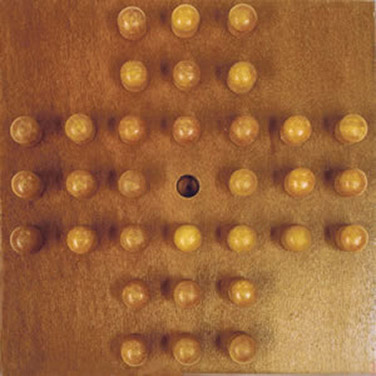Solitaire

The most common form of this one-player game of patience consists of a board with thirty-three holes in the shape of a cross and thirty-two pegs. The hole in the centre is empty at the beginning of the game. The pegs are removed one by one by jumping over them in a vertical or horizontal direction. At the end, one peg should remain in the middle. There are also other boards which differ in shape and the number of holes. In a more difficult version, a particular predefined pattern should remain at the end of the game.
History
The origin of the game is uncertain. There is evidence that suggests it was played in France in the late seventeenth century and quickly spread all over the world. One famous player was Gottfried Wilhelm Leibniz, who also played the game in reverse, i.e. starting with only one peg.
Mathematics
Solitaire was one of the first games to be analysed mathematically. Michel Reiss published his article "Beiträge zur Theorie des Solitär-Spiels" (Contributions to the Theory of Solitaire) in the "Journal für die reine und angewandte Mathematik" in 1857.
The question as to the possible end positions was tackled later using algebraic methods. Nicolas Govert de Bruijn analysed them with the aid of the finite field with four elements (1972). Computer programmes and recursive back-tracking can also be used to study whether there is a solution for a given end position from a particular starting position.